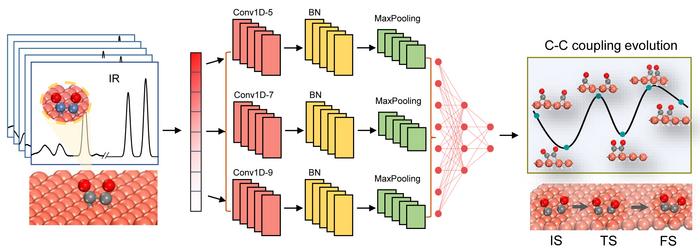
In recent years, the intersection of artificial intelligence and scientific research has garnered immense attention, particularly in the field of catalytic reactions. A fascinating study led by Associate Professor Li Yang, along with prominent scholars Prof. Sheng Ye of Anhui University, Prof. Thomas Heine of Technische Universität Dresden, and Prof. Jun Jiang of the University of Science and Technology of China, has pushed the boundaries of our understanding in this area. Their research utilizes advanced machine learning protocols alongside infrared spectroscopy to monitor critical C–C coupling processes during catalytic reactions. This innovative approach provides a non-invasive pathway to track and predict molecular transformations based on spectroscopic data.
Infrared spectroscopy has long been recognized for its ability to analyze molecular structures due to its sensitivity to various molecular vibrations. However, the challenge has always been to translate this spectroscopic data into actionable insights regarding atomic-level dynamics in complex catalytic processes. The researchers addressed this necessity by integrating machine learning techniques with infrared spectroscopic data, creating a framework that efficiently maps spectroscopic fingerprints to detailed atomic structures.
C–C coupling reactions, wherein two carbon atoms bond to form a larger carbon framework, are essential in organic synthesis, yet they pose substantial challenges due to the dynamic environments in which they occur. In their study, the authors chose to examine the interaction of two adjacent carbon monoxide (CO) intermediates as a model reaction. By applying a convolutional neural network (CNN) design that comprises multiple processing blocks and a fully connected layer, they achieved a remarkable ability to predict local atomistic structures and energetic variations based on the evolving spectroscopic data.
The researchers meticulously investigated multiple dynamic trajectories of C–C coupling occurring on a copper (Cu) surface. Their neural network framework displayed astute predictive capabilities, allowing for the accurate characterization of the structural rearrangements that take place during the catalytic process. By deconstructing the IR spectroscopy data, they successfully recapitulated the evolution of local atomic configurations, paving the way for a more economically viable strategy to monitor C–C coupling in real-time.
An essential aspect of C–C coupling involves the CO–CO dimerization reaction, which is key to understanding the broader context of these catalytic processes. The team expanded their machine learning model’s application to specifically analyze the CO–CO dimerization occurring on Cu surfaces. This endeavor revealed critical molecular configurations and energy barriers, offering new insights into the reaction profiles that characterize these processes. Their findings indicate that even in the face of unfamiliar catalytic environments, the machine learning model can effectively identify reaction pathways, showcasing its versatility and robustness.
What sets this research apart is not only the successful integration of machine learning and spectroscopy but also the validation of their findings against previous experimental results. The predicted influence of metal dopants on enhancing CO–CO dimerization aligns with established experimental data, underscoring the reliability and applicability of the machine learning model they developed. This correlation further solidifies the framework’s utility in both theoretical and experimental settings.
As Dr. Li Yang and his collaborators delve deeper into the nuances of their study, they have highlighted the importance of incorporating both computational and experimental methodologies. The accessibility of spectroscopic fingerprints through these approaches enhances the practicality and adaptability of their machine learning protocol, making it an invaluable tool for tracking the intricate structural evolution involved in catalytic reactions.
The implications of this research extend far beyond mere academic interest. The ability to accurately monitor and predict molecular transformations represents a significant leap forward in chemical reaction research. With the advent of machine learning tools, scientists can harness vast amounts of spectroscopic data to refine models further and glean insights that were previously unattainable. This paradigm shift towards “AI for Science” showcases the immense potential of these technologies to unlock new frontiers in the understanding of complex chemical processes.
Additionally, the researchers emphasize the importance of continuous refinement of their machine learning model. By incorporating experimental data, they can capture real-world environmental influences, leading to models that are not only theoretically sound but also practically applicable. This integration fosters an iterative feedback loop that promises to enhance the accuracy and predictive power of their framework as new data emerges.
The collaborative nature of this research is also noteworthy, as it showcases the necessity of interdisciplinary efforts in tackling complex problems in science. The combination of expertise in infrared spectroscopy, first-principles calculations, and machine learning exemplifies how cross-disciplinary collaborations can lead to groundbreaking advancements. The collective insights from the diverse academic backgrounds of the researchers enriched the study, providing a comprehensive understanding of the intricate phenomena they investigated.
In conclusion, the study led by Dr. Li Yang and his team represents a monumental step forward in utilizing machine learning for monitoring catalytic reactions. By effectively marrying spectroscopy with cutting-edge computational techniques, they have opened up new avenues for exploration and understanding in chemical research. Their work exemplifies not only the potential of AI in scientific endeavors but also the promise of future innovations that can significantly reshape our approach to catalysis and molecular transformations in the coming years.
Subject of Research: Machine learning protocols for monitoring C–C coupling in catalytic reactions using infrared spectroscopy
Article Title: Monitoring C–C coupling in catalytic reactions via machine-learned infrared spectroscopy
News Publication Date: October 2023
Web References: DOI link
References: National Science Review
Image Credits: Art by Li Yang and Sheng Ye
Keywords
Artificial intelligence, machine learning, infrared spectroscopy, catalytic reactions, C–C coupling, CO dimerization, convolutional neural networks, structural evolution, non-invasive methods, chemical reactions.





